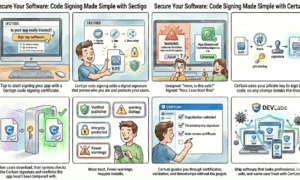How do you know it’s time to re-evaluate your Enterprise Information Management (EIM) strategy? Actually, here’s a better question – when was the last time you actually looked at it?
Most organizations set up their EIM frameworks years ago and haven’t revisited them since. For those unaware, EIM is how companies capture, store, and manage all their information assets. In recent years, the reliance on EIM software has grown exponentially. EIM market software size is projected to climb to $439.95 billion by 2033.
However, despite major investments in these systems, cracks continue to appear, allowing serious problems to slip through. For instance, poor information management creates serious problems that compound over time. Weak practices create pathways for identity theft and misinformation to flourish.
They open multiple vulnerability windows that exponentially increase your data breach risk. Recent findings indicate the average breach now costs U.S. companies over $10 million. That number should make every executive sit up straight.
Today, we will focus on the warning signs that your EIM strategy needs a refresh. But before we get down to that part, it’s important to be aware of:
Common EIM Implementation Mistakes
Learning from others’ missteps can save you considerable time and money in the long run. Here are the traps that catch most organizations off guard, according to WoodWing:
Overcomplicating the Solution
Many companies build enterprise information management systems that try to do too much. They pack in excessive functionality and create convoluted processes that confuse everyone involved. Users resist adoption when things feel unnecessarily complicated.
Neglecting Data Quality
Poor data quality silently sabotages every other effort you’re making to improve operations. When information is inaccurate or incomplete, the analysis becomes unreliable. Workflows lose pace as teams must second-guess data they cannot rely on.
Decisions get made based on faulty assumptions that seemed solid at the time. Treat data quality as an ongoing commitment that never truly ends, not just a one-time spring cleaning project you check off and forget about.
Letting Technology Override Strategy
Technology is critical, but it’s not the whole story. Many organizations focus exclusively on implementing new tools while overlooking the human elements that make them effective.
Your EIM approach needs to address policies, processes, employee skills, and organizational culture, in addition to the technology itself. The fanciest system in the world won’t help if nobody understands how to use it properly.
The warning signs of an outdated EIM strategy don’t usually hit you all at once. They creep up slowly until one day you realize you’re dealing with a mess that could have been avoided.
Signs That Your EIM Strategy Is Outdated and Needs Re-evaluation
Your EIM strategy might have been solid a few years back, but technology and business needs evolve faster than most of us can keep up with. Here are the telltale signs that what you’re doing now isn’t cutting it anymore.
Your Data is Siloed
If your teams are struggling to access information across different departments, that’s a problem worth addressing. When data gets trapped in separate systems, it creates blind spots across your entire organization.
Data silos become the entry point to a cascade of operational failures. Your employees waste hours searching for information that should be readily available.
They make decisions based on incomplete pictures because the full story is locked away in someone else’s system. Your customers also feel it when different departments give them conflicting information or can’t see their complete history. Trust erodes one disconnected interaction at a time.
Breaking down these silos needs to be a top priority. Your EIM strategy should create pathways that let information flow freely while maintaining proper security controls along the way. Create a culture where hoarding information is seen as counterproductive rather than powerful.
Your Data Isn’t Properly Secured
If your security protocols aren’t up to date or aren’t integrated across your entire system, you’re leaving your business vulnerable. Data breaches do not materialize on their own. They happen because of weak access controls, outdated security measures, or vulnerabilities hiding in your storage infrastructure.
Without robust protection, you risk exposing sensitive information that can lead directly to identity theft, financial losses, and reputation damage that can take years to repair.
A bullet-proof EIM strategy hardwires security into every layer of your information ecosystem. Robust encryption safeguards data both when stored and during transfer between systems.
Clear access controls ensure only authorized personnel can view or modify sensitive information based on their actual job requirements. Role-based permissions mean your marketing intern isn’t accidentally stumbling into payroll data.
If security feels like an afterthought in your current strategy rather than a foundation, that gap should be addressed immediately. Recent incidents make the urgency crystal clear.
Take the newly discovered vulnerability in Oracle E-Business Suite that the Cl0p ransomware group has been actively exploiting in real-world attacks. These aren’t theoretical risks we’re talking about. Bad actors are out there right now scanning for weaknesses in enterprise systems just like yours.
You Are Drowning in Compliance Requirements
If your team spends more time worrying about regulatory compliance than actually using your data, something’s off balance. Compliance is critical, but it shouldn’t paralyze your entire operation or turn every data request into a legal nightmare.
The regulatory landscape keeps getting more complex every year. GDPR, CCPA, HIPAA, SOX, and dozens of industry-specific regulations all demand different things from your data management. Each one comes with its own rules about retention, access, deletion, and reporting.
This is precisely where outdated EIM strategies really show their cracks. Manual compliance tracking is a recipe for mistakes that can cost you dearly. Serious GDPR violations alone can trigger penalties reaching €20 million (approximately $21 million) or 4% of global annual revenue, whichever amount is higher. One oversight can trigger penalties that will make your CFO lose sleep for months.
Your current system probably can’t tell you where all copies of a particular customer’s data live across your infrastructure. It likely can’t automatically apply retention policies or flag information that should have been deleted months ago. These gaps don’t just create compliance risk; they expose you to legal liability that grows with every passing day.
A modern EIM strategy automates most compliance workflows so your team can focus on strategic work instead. It tracks data lineage, applies policies consistently, and generates audit trails without constant manual intervention, keeping everything running smoothly.
Time to Build Something Better
Putting together the right EIM strategy takes time, work, and regular updating. The fact that you’re reading this and recognizing these signs means you’re already ahead of the curve. Your willingness to re-evaluate shows the kind of forward thinking that separates thriving organizations from struggling ones. Take what you’ve learned here, start with the biggest pain point your team faces daily, and build momentum from there.





























